How To Break A Fast In Intermittent Fasting
If you’re exploring the world of intermittent fasting (IF), you’ll learn about its many benefits. But here’s something equally important – how you break your fast in intermittent fasting. It’s not just about the discipline of not eating; it’s about reintroducing food into your system to maintain those fasting benefits and prevent digestive discomfort.
People with diabetes, heart disease, severe insulin resistance, liver or kidney disease should avoid fasting or consult with their healthcare provider before starting. Even if you are perfectly healthy, getting a professional opinion is always a good idea to ensure your fasting plan aligns with your weight loss goals.
I’m here to help you with that critical first step when your fast ends. Begin with small portions and easily digestible foods to ease your digestive system back into action. Starting small could mean sipping on some bone broth, known for its hydrating qualities and being gentle on an empty stomach, or blending a smoothie made of fruits and vegetables; these are simple to digest and don’t overload your system after the fasting period.
Consider including fermented foods like sauerkraut, yogurt, or kefir, rich in probiotics that promote gut health, as an excellent option for breaking your fast. Fermented foods can further encourage the “good” bacteria to repopulate. Additionally, opt for low-sugar fruits such as berries or watermelon, offering natural sweetness without causing a significant spike in sugar levels.
Now, let me tell you why staying hydrated is a big deal.
- Water: Always essential to stay hydrated.
- Herbal Teas: Organic Honeybush, Chamomile, peppermint, ginger.
- Coconut Water: Natural electrolyte replenishment.
- Black Coffee: No Cream or Sweetener.
Ensure you drink plenty of water before and after breaking your fast. It’s not just about quenching your thirst; it’s about preparing your body to receive nutrients again and maintaining hydration throughout the rest of your day.
Lastly, be mindful of how much you eat. Overeating right after fasting can lead to digestive issues and cancel out the benefits of IF. Also, chew your food well to aid digestion and help signal when you’re full. I can’t emphasize this enough: listen to your body. If it signals that you’re satisfied, put the fork down. It’s better to eat too little at this stage than too much.
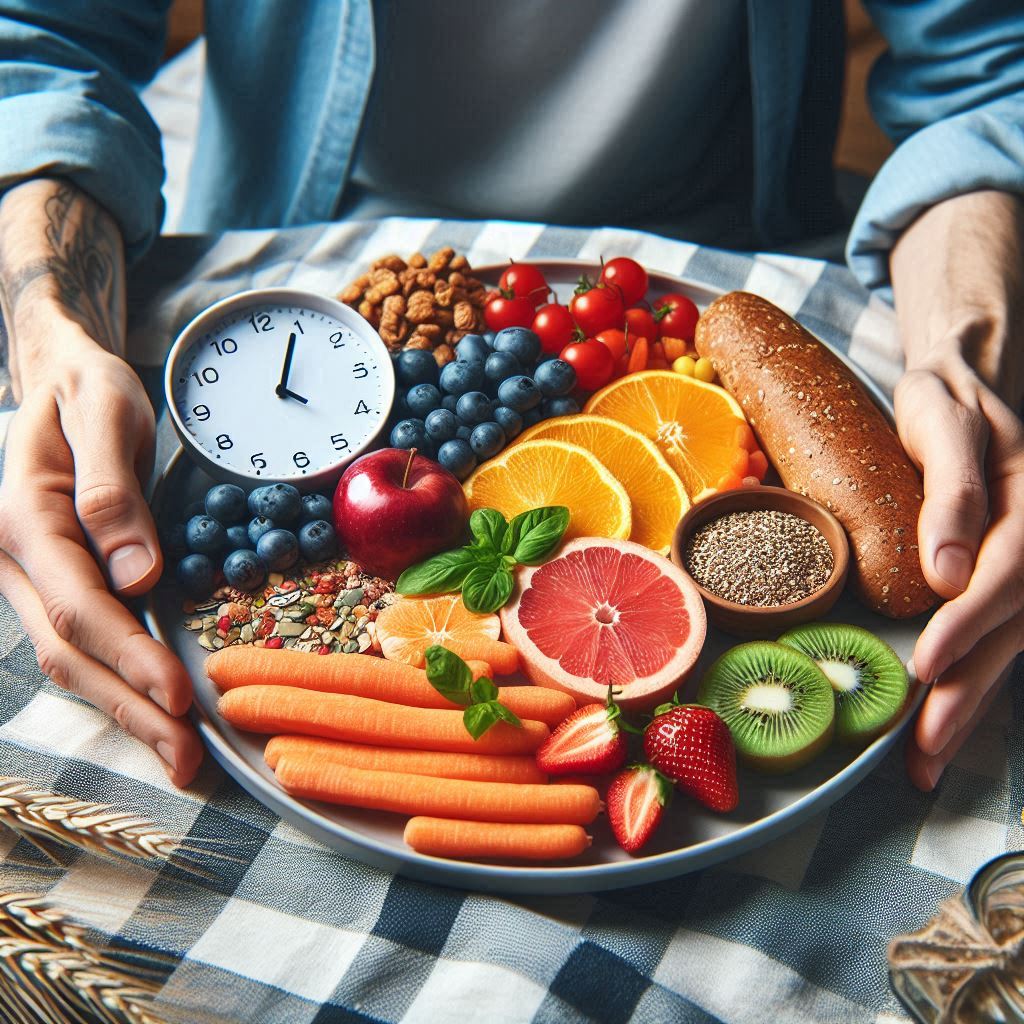
Next, I will discuss essential proteins to stabilize your body and ensure optimal benefits.
Incorporating Proteins: Stabilizing Your Body Post-Fast
I will explain the significance of lean proteins in your meals that follow your initial break. Introducing proteins is your next move after gently awakening your digestive system with something light.
That will include options like chicken or turkey breast, eggs, and fish. These lean proteins are rich in essential nutrients and are excellent at promoting a sense of fullness while stabilizing blood sugar levels. This helps ward off those spikes and crashes that make you tired or irritable.
Here is a list of High-Quality Proteins:
- Egg Whites: High in protein and low in calories and fat.
- Chicken Breast: Skinless and boneless, it’s a low-fat, high-protein option that can be grilled or baked but not fried.
- Lean Ground Meat: This type of ground turkey or ground chicken with a lower fat content.
- Turkey Breast: Lean and high in protein, consumed skinless. They were grilled or baked.
- Fish: Such as salmon, mackerel, sardines, and trout, which are high in omega-3 fatty acids. (grilled or baked).
- Tofu: A plant-based protein that is low in fat and versatile for various dishes. Lightly cooked or added to salads.
Now, let’s talk about caring for your digestive system, and one part of that is managing portion sizes. Overeating is counterproductive, especially after your body has had a break from digesting food. A modest portion of protein is all you need to get started.
Chewing your food well plays a crucial role here. It helps break down the food and sends signals to your brain to prepare for digestion. This mechanism can help prevent indigestion and aid in better absorption of nutrients. Plus, the simple act of chewing more can help you feel fuller and faster.
Healthy fats are vital for providing your body with sustained energy. In the next section, we’ll discuss incorporating foods like avocados, seeds, nuts, and olive oil into your post-fasting meals and how they combine with proteins to support your well-being.
Supporting Sustained Energy with Healthy Fats
I will shine a light on the role of good fats when breaking a fast. After gently reintroducing proteins into your meal, next up, you want to focus on fats. But not just fats; we’re talking about the types that offer sustained energy and don’t stress your digestive system after your fasting period.
Why are fats like avocados, nuts, seeds, and olive oil supportive following an intermittent fast? These monounsaturated and polyunsaturated fat sources can help manage inflammation and sustain energy levels.
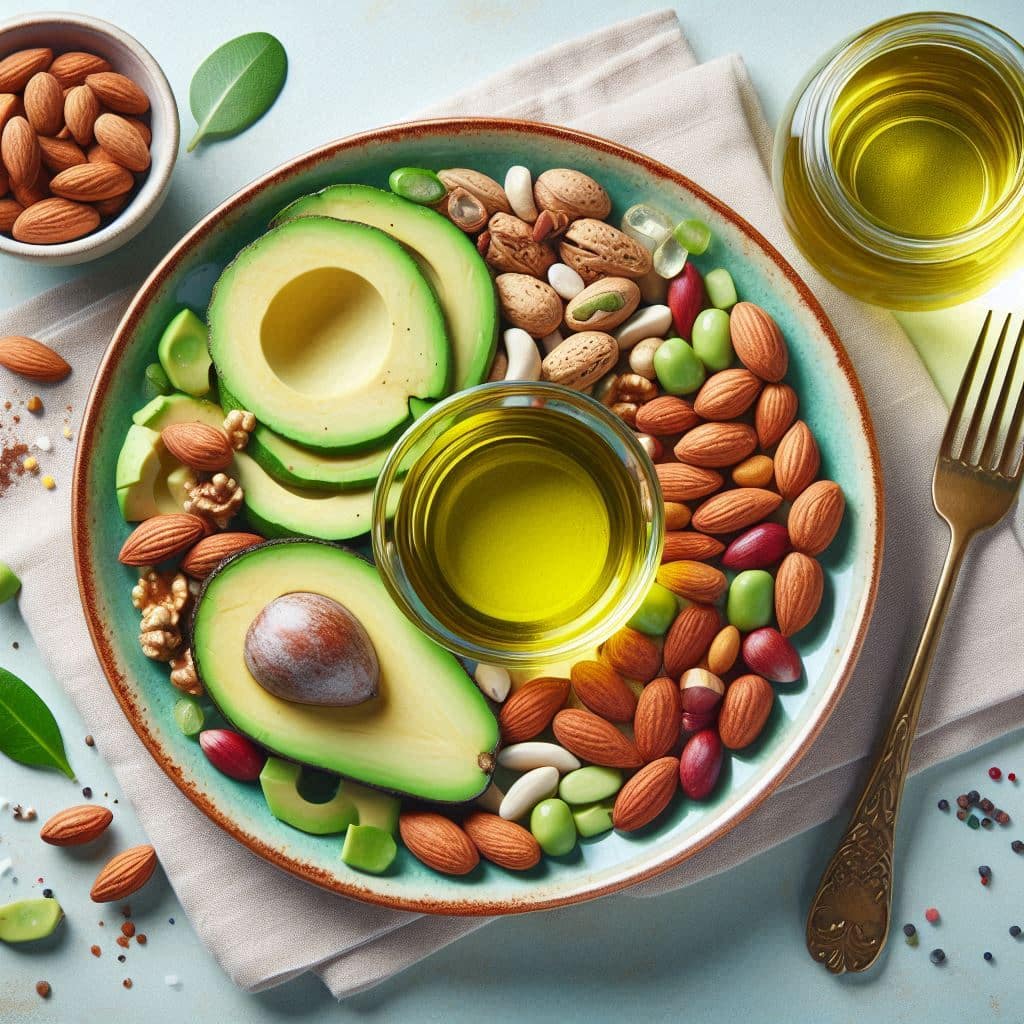
Here is a list of Beneficial Good Fats
- Avocado: Sliced or mashed. Rich in monounsaturated fats and various vitamins and minerals.
- Nuts and Seeds: Almonds, walnuts, cashews, and pistachios are rich in protein, good fats, and fiber.
- Nut Butter: Almond butter or Peanut butter (unsweetened). They are rich in good fats and protein.
- Oils: Olive oil or Coconut oil. High in monounsaturated fats and antioxidants.
- Full-Fat Yogurt: Contains beneficial probiotics, protein, and good fats.
- Olives: A good source of monounsaturated fats and antioxidants.
Including these in your meals isn’t just about satiety and energy; they also play a crucial role in absorbing fat-soluble vitamins. Vitamins A, D, E, and K require fats for proper absorption, and since you’ve been fasting, your body is eager to use these nutrients effectively.
You might wonder how to incorporate these fats without going overboard. Choose something that resonates with you. For instance, a small amount of olive oil in a salad or a handful of almonds can pack a nutrient-dense punch without overwhelming your digestive tract.
Adjusting your approach down the road is perfectly fine. You can always find the right balance that suits your body and fasting regimen. Stay tuned for section 4, where we’ll discuss returning complex carbohydrates to your diet to round out your post-fasting meals.
How To Break A Fast with Raw Vegetables
Vegetables can play an essential role in this process, providing a gentle and nutritious way to ease your body back into digestion.
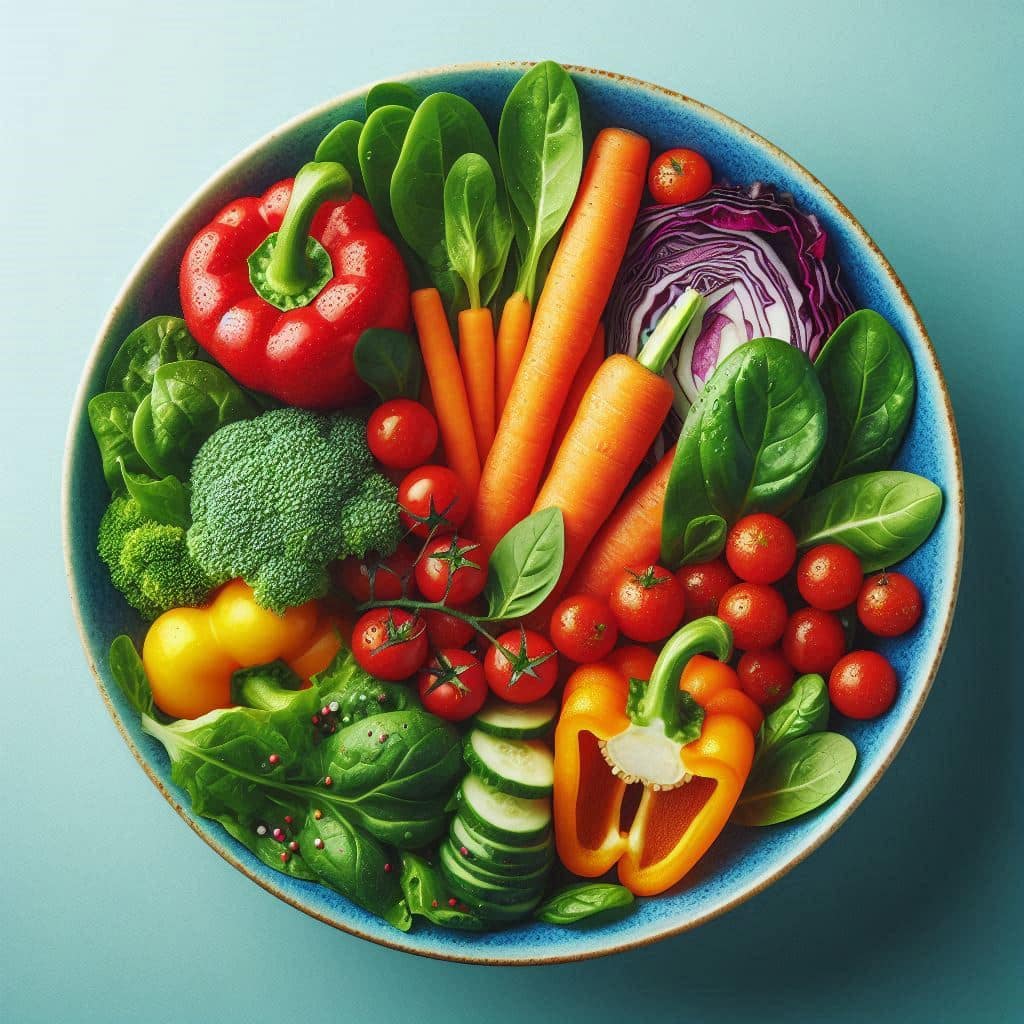
Benefits of Breaking a Fast with Vegetables
Vegetables have antioxidants, vitamins, and minerals, making them an excellent choice for breaking a fast. Here are some of the benefits:
- Hydration: Many vegetables have high water content, helping to rehydrate your body after fasting.
- Fiber: Fiber supports digestion and helps you feel full, which can prevent overeating after a fast.
- Nutrient Density: Vegetables provide essential nutrients without adding excessive calories, supporting overall health and well-being.
- Gentle on the Stomach: Vegetables are less likely to cause digestive discomfort than heavier, more processed foods.
Best Vegetables to Break a Fast
When breaking a fast, choosing vegetables that are easy to digest and nutrient-dense is essential. Here are some of the best options:
- Cucumbers: Hydrating and low in calories, cucumbers are gentle on the stomach.
- Carrots: Rich in beta-carotene and fiber, carrots are a great way to start reintroducing nutrients.
- Bell Peppers: It has vitamins A and C, and bell peppers provide a nutrient boost..
- Celery: It has low calories and high water content. Celery is perfect for rehydration.
- Cherry Tomatoes: Packed with antioxidants, cherry tomatoes offer a tasty and nutritious option.
- Zucchini: Easy to digest and hydrating, zucchini is a versatile choice.
How to Incorporate Vegetables into Your Post-Fast Meal
To break your fast with vegetables, follow these simple steps:
- Start Slowly: Begin with a small portion of vegetables to see how your body reacts. A light salad or a small plate of sliced vegetables is a good start.
- Combine with Healthy Fats: Pair your vegetables with good fats like avocado or olive oil to help your body absorb fat-soluble vitamins.
- Add Protein Gradually: To balance your meal, you can add a small amount of protein, such as a boiled egg or a handful of nuts.
- Stay Hydrated: Drink plenty of water or tea to aid digestion and rehydration.
Breaking a fast with vegetables is a smart and nutritious choice. They provide essential nutrients, promote hydration, and are gentle on the digestive system. By starting with small portions and gradually incorporating other food groups, you can effectively ease your body into regular eating while maximizing the health benefits of your intermittent fasting routine.
Balancing Your Diet with Complex Carbohydrates
Nailing the timing and selection of complex carbohydrates is crucial in the post-IF feeding period. Complex carbohydrates, like brown rice, quinoa, and legumes, provide essential energy, dietary fiber, and a variety of phytonutrients.
Include foods like brown rice, quinoa, or oats in your meals. These versatile grains are perfect for gently increasing your intake of complex carbs and helping with digestive health.
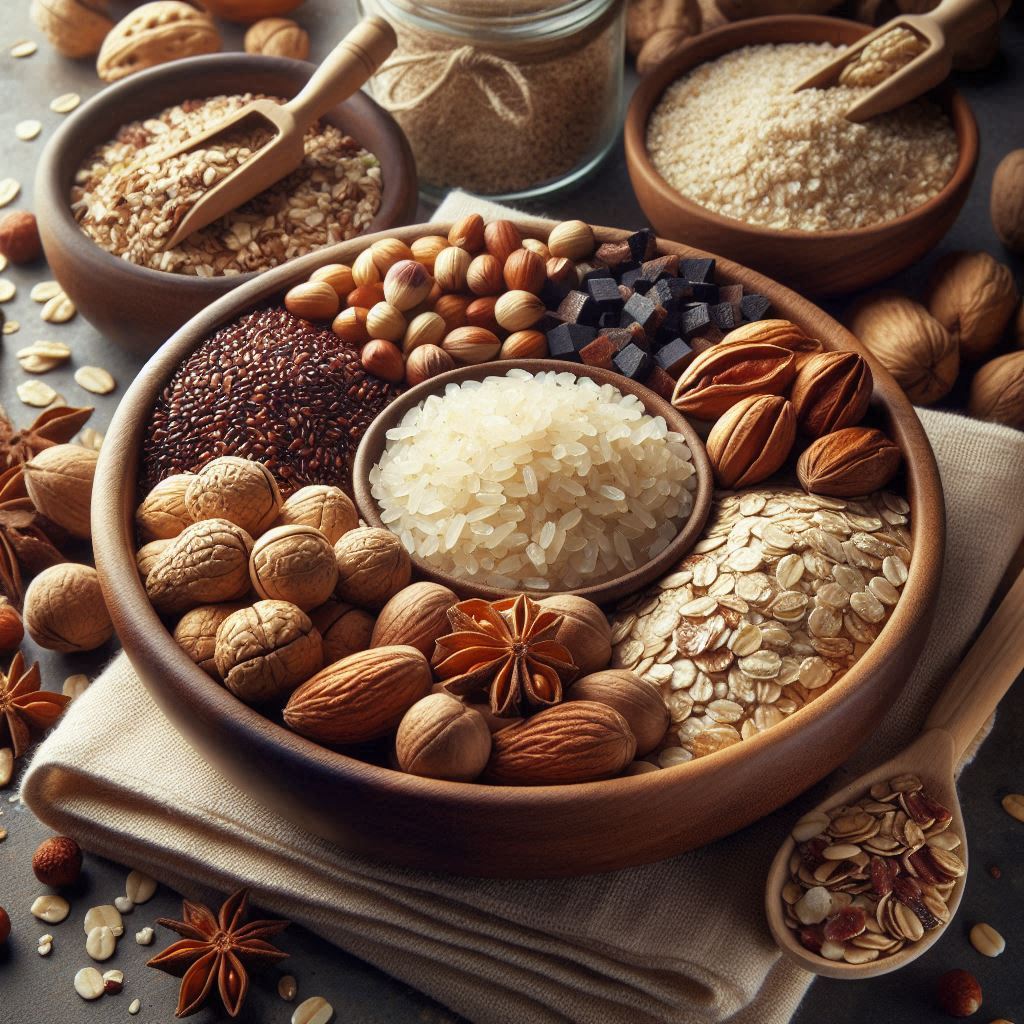
Below is a list of complex carbohydrates for transitioning from a fast state to eating. We can start with beneficial whole grains:
-
- Brown Rice: A good source of fiber and provides steady energy.
- Oats: High in fiber, particularly beta-glucan, which can help you feel full longer.
- Whole Wheat: Provides fiber, protein, and essential vitamins and minerals.
Now, here are some Legumes that are beneficial:
- Lentils: High in protein, fiber, iron, and folate.
- Black Beans: High in protein, fiber, and antioxidants.
- Kidney Beans: Good source of protein, fiber, and several essential nutrients, such as iron and folate.
- Navy Beans: High in protein, fiber, and several B vitamins.
- Pinto Beans: Rich in protein, fiber, and several nutrients, including magnesium and iron.
- Green Peas: High in protein, fiber, and vitamins, including vitamins K and C.
- Edamame (Soybeans): Rich in protein, fiber, and several vitamins and minerals, including calcium and iron.
- Lima Beans: Good source of protein, fiber, and several nutrients, including potassium and iron.
And lastly, here are some Starchy Vegetables that are beneficial:
- Potatoes: Rich in potassium, vitamin C, and fiber (especially if you eat the skin).
- Sweet Potatoes: High in beta-carotene, fiber, and vitamin A.
- Corn: Provides fiber, B vitamins, and antioxidants.
- Peas: A fiber, protein, and various vitamins and minerals source.
- Yams: High in fiber, potassium, and vitamins C and B6.
- Pumpkin: Contains fiber, beta-carotene, and vitamin C.
- Beets: Rich in folate, fiber, and antioxidants.
Preparation is also essential. For example, try a warm, comforting bowl of oats with your favorite seeds and nuts or a colorful quinoa salad mixed with greens, cherry tomatoes, and avocado. Legumes, like beans or lentils, can be excellent in soups or as side dishes.
A slow and measured approach to reintroducing complex carbs will help your digestive system adjust and support the fasting benefits. It encourages balance in the body’s energy systems and lays the groundwork for a wholesome eating pattern.
To maximize your post-fast nutrition, choose from these complex carbohydrate options and incorporate them into a meal you’ll enjoy. Below, I have included a small meal plan to get you started.
Example Meal Plan:
First Meal (Light and Easy)
- Smoothie: Spinach, banana, berries, and almond milk.
- Fruit: A small bowl of watermelon.
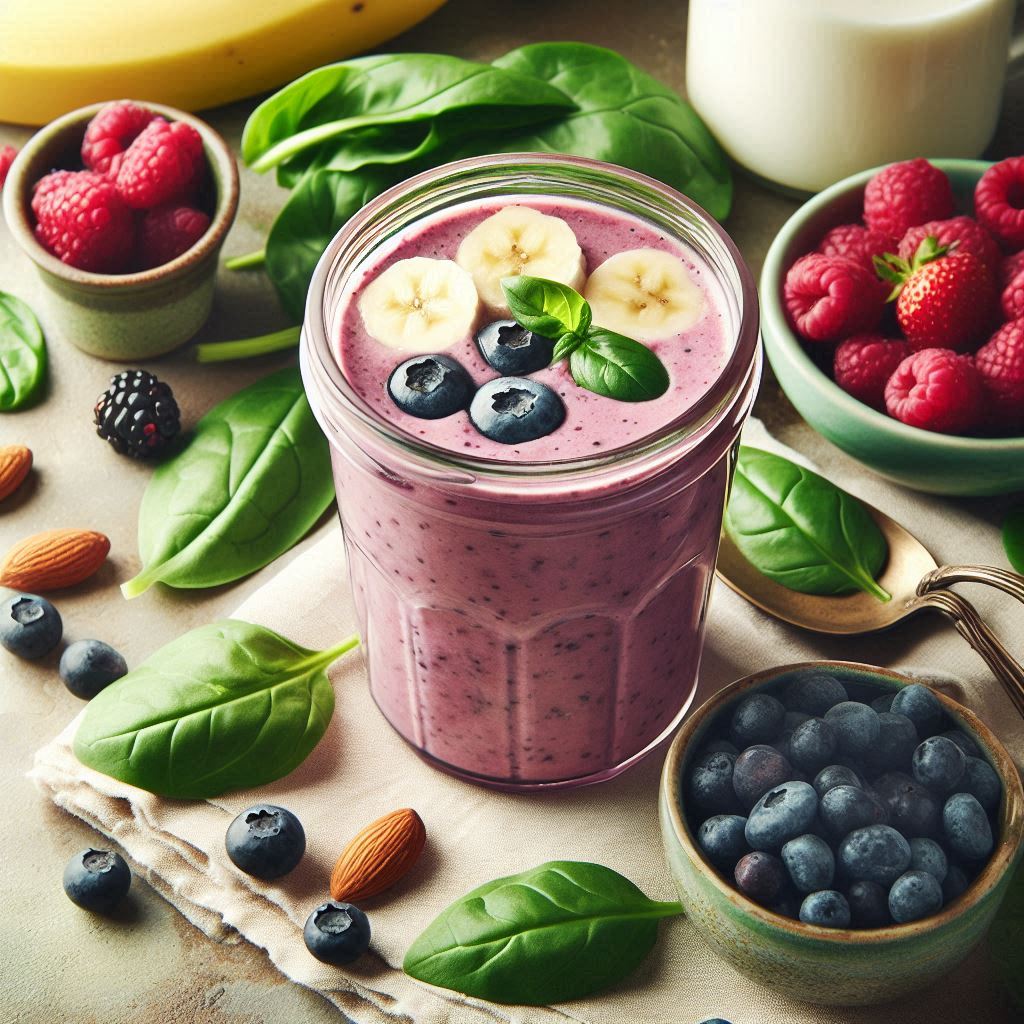
Second Meal (Introduce Protein)
- Protein: Grilled chicken breast or a boiled egg.
- Vegetable: Steamed carrots and broccoli.
- Healthy Fat: Sliced avocado.
Third Meal (Balanced Meal)
- Whole Grain: Quinoa salad with mixed greens, cherry tomatoes, and olive oil.
- Protein: Grilled fish (salmon or tilapia).
- Fermented Food: A small serving of plain yogurt with a handful of berries.
Don’t worry too much about perfecting it the first time. You can continually adjust your approach based on your body’s response. Remember, your first attempt doesn’t need to be your last.
Summary
This guide on breaking a fast has been helpful. Follow it to ensure a comfortable and smooth transition from fasting to eating, maximizing the health benefits of intermittent fasting.
Remember to be mindful of your body’s signals as you reintroduce these foods, stay hydrated, and avoid the urge to overeat. You set the stage for sustained health and well-being by pacing yourself and choosing the right foods. Take your time, listen to your body, and enjoy the nourishing benefits of a well-balanced meal.
So, my question to you today is: Are you ready to embrace the path to a balanced diet with intermittent fasting? If you found this article helpful, check out my other article: Why Am I Gaining Weight On Intermittent Fasting?
Engage with Me!
Ask Questions: I would love to hear your feedback or questions on whether you enjoyed our discussion about how to break a fast intermittent fasting. Please share your experiences and thoughts below, and let’s continue supporting each other on this health-conscious journey!
FAQ: Breaking a Fast in Intermittent Fasting
IF is a popular dietary approach that involves cycling between periods of eating and fasting. Understanding what to eat when breaking a fast is important to maximize the benefits and avoid potential adverse effects. Below are some frequently asked questions about breaking a fast and their answers.
What is the best thing to eat after intermittent fasting?
The best foods to eat after fasting are nutrient-dense, easily digestible, and provide a good balance of protein, healthy fats, and carbohydrates. Some great options include:
- Fresh fruits and vegetables
- Lean proteins like chicken, fish, or tofu
- Fats such as avocado, nuts, and seeds
- Whole grains like quinoa, brown rice, or oats help replenish your body’s nutrient stores and stabilize blood sugar levels.
What not to eat after fasting?
After fasting, avoiding foods high in sugar, refined carbs, and unhealthy fats is best, as they can cause digestive discomfort and blood sugar spikes. Specifically, try to stay away from:
- Sugary snacks and desserts
- Fried and processed foods
- High-glycemic foods like white bread and pastries
- Large portions of red meat. These foods can make you feel sluggish and negate the benefits of your fasting periods.
Are eggs good to break a fast?
Yes, eggs are an excellent choice for breaking a fast. They are high in protein, minerals, and vitamins, making them a nutritious and satisfying option. Eggs help stabilize blood sugar levels and provide the energy to keep you going throughout the day. They are also easy to digest.
Can I eat bananas after fasting?
Yes, bananas are an excellent option for eating after fasting. Bananas contain potassium, vitamin B6, and fiber, which can help replenish your body’s nutrients and aid digestion. They are also easily digestible and provide a quick energy source, making them ideal for your post-fast meal.
Which raw fruits are best for an empty stomach?
The best fruits on an empty stomach are easily digestible and packed with nutrients. Some excellent choices include:
- Watermelon: It’s hydrating, low in calories, and rich in vitamins A and C.
- Berries: Raspberries, Strawberries, and Blueberries are high in fiber and antioxidants, which are great for digestive health and overall well-being.
- Apples: Packed with vitamins and fiber, apples can help you feel full and provide a steady energy source. These fruits are gentle on the stomach and provide a healthy dose of minerals, vitamins, and antioxidants to start your day right.

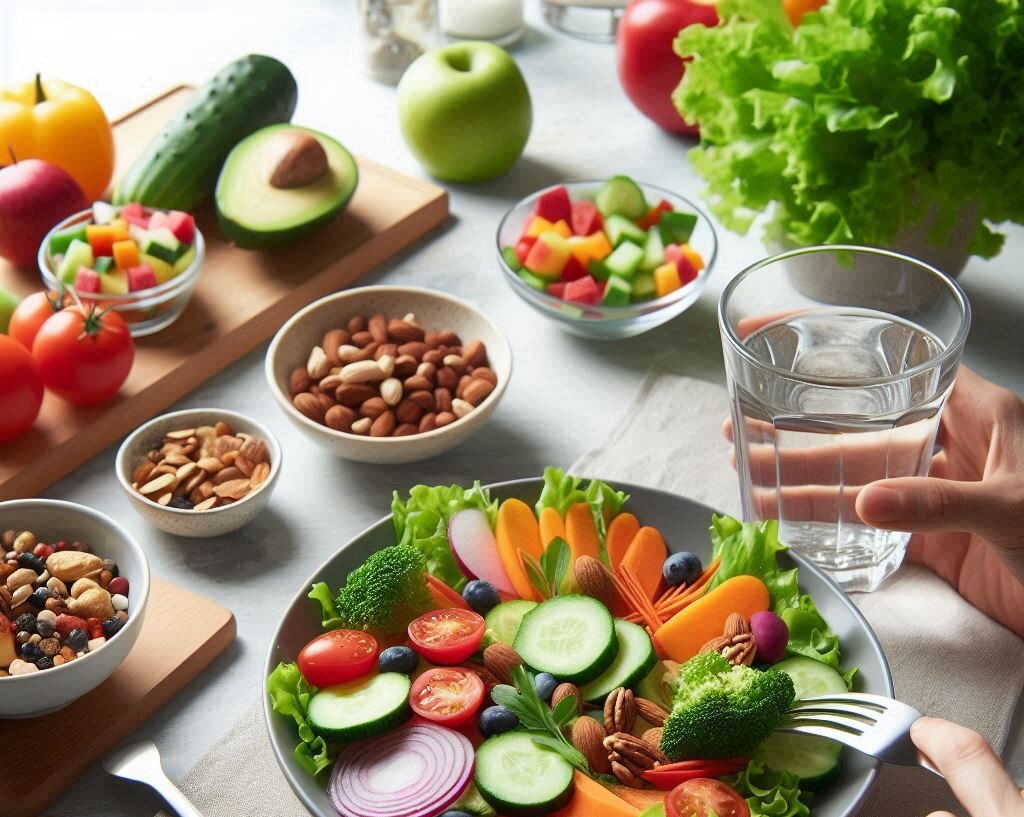
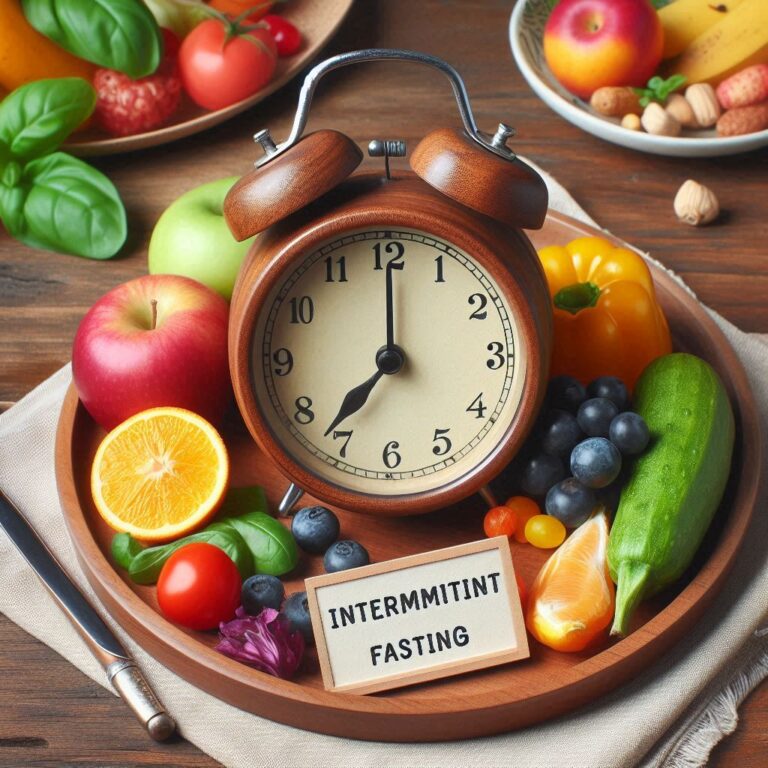
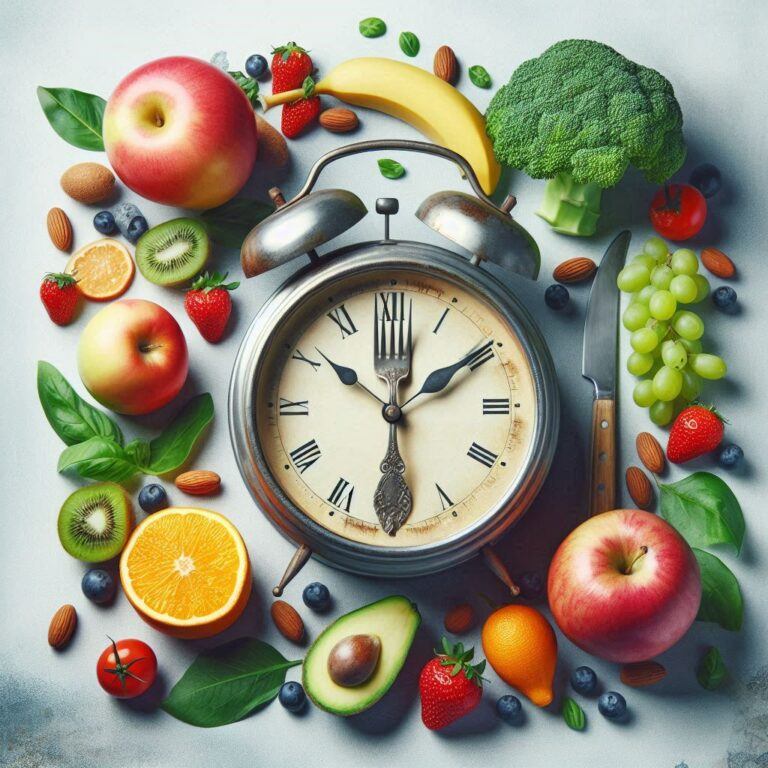
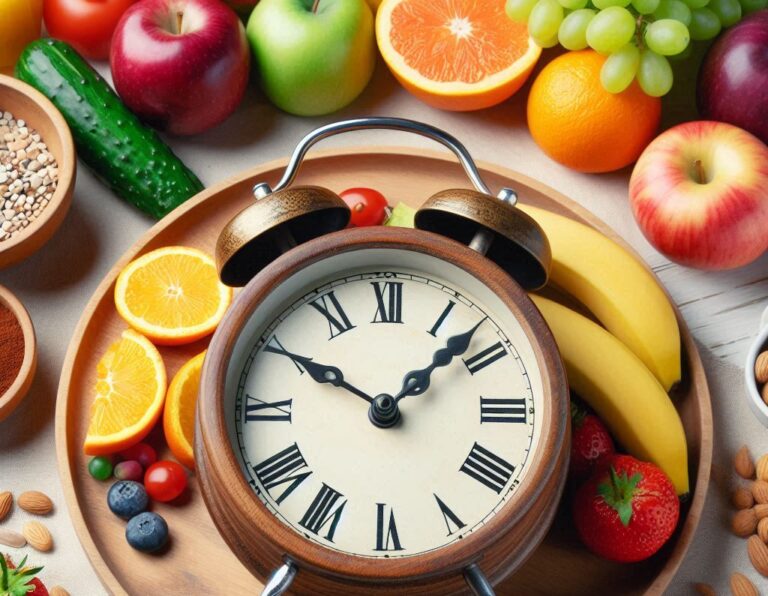



Hey a great post you have here!
I enjoy reading posts that are based on creating and maintaining a healthy lifestyle.
I like how you ensured to mention eating a lot or till you are full after fasting isn’t great as that is what people instinctively do. Your post certainly contains a lot of essential information that I shall take note of!
Thanks again and have a great day!
Hi there!
Thank you so much for your kind words!
I’m glad you enjoyed the post and found the information useful. It’s important to find a balanced approach to eating, especially after fasting. Your feedback is greatly appreciated, and I’m thrilled to hear you’ll be taking some of these tips to heart.
Come back and read some more helpful articles. Have a wonderful day, and thanks again for reading!
Best regards,
Michael
Hi there
I like that your article on how to break a fast in intermittent fasting offers practical and health-conscious advice. It emphasizes the importance of starting with small, nutrient-dense meals and gradually reintroducing regular eating patterns to prevent digestive discomfort.
This thoughtful approach ensures that the body smoothly transitions from a fasting state, promoting overall well-being.
Have you found any specific meal suggestions particularly helpful when breaking your fast?
Hi there,
Thank you for your kind words about the article!
I’m glad you found the advice practical and health-conscious. Breaking a fast with small, nutrient-dense meals is crucial for a smooth transition and overall well-being. I’ve found that starting with a light, protein-rich meal works best for me. Foods like Greek yogurt with berries or a handful of nuts and an apple have been beneficial.
All the best,
Michael
Hi Michael,
As someone who enjoys intermittent fasting, I found this blog post incredibly insightful and practical. Breaking a fast properly is crucial, and the advice here on starting with small, easily digestible foods is spot on. I particularly appreciate the emphasis on hydration and the detailed guidance on incorporating proteins, healthy fats, and complex carbohydrates. This holistic approach ensures a smooth transition from fasting to eating, maintaining the benefits of intermittent fasting and preventing digestive discomfort. The suggested meal plans are a great starting point, offering balanced and nutritious options. Thanks, Michael, for this comprehensive guide! It’s a fantastic resource for anyone on an intermittent fasting journey.
– Scott
Hi Scott,
Thank you for your feedback! I’m glad to hear that you found the blog post on breaking a fast both insightful and practical.
Intermittent fasting can be incredibly beneficial when done correctly, and starting with small, easily digestible foods is indeed key. Hydration, as you mentioned, plays a crucial role in ensuring a smooth transition from fasting to eating, and yes, incorporating proteins, healthy fats, and complex carbohydrates is essential.
I’m pleased to hear that the meal plan provided a good starting point for balanced and nutritious options. Your appreciation and positive feedback are truly motivating.
Thank you again for sharing your experience and thoughts. I Wish you continued success on your intermittent fasting journey!
All the best,
Michael
Great article, Michael! You’ve provided a lot of valuable information on how to break a fast properly while practicing intermittent fasting. I appreciate the emphasis on starting small and gradually reintroducing different food groups.
For those who have experience with intermittent fasting, how have you found your body responds to different foods when breaking a fast? Have you noticed any specific foods that work particularly well or cause discomfort?
I’m also curious about the role of hydration. How much water or other fluids do you typically consume before and after breaking a fast? Are there specific herbal teas or electrolyte drinks that you find especially beneficial?
Lastly, regarding complex carbohydrates, how do you balance these with proteins and fats in your meals? Any favorite recipes or meal ideas that incorporate these elements effectively?
Looking forward to hearing everyone’s experiences and tips! Let’s help each other navigate and optimize our intermittent fasting journeys.
Cheers Graham
Hi Graham,
Thank you for your kind words! I’m glad you found the article helpful.
From my experience and feedback from others, the body responds quite differently to various foods when breaking a fast. Generally, starting with light, easily digestible foods like fruits, vegetables, and soups can help ease the transition. I’ve found that fermented foods like yogurt or kefir work particularly well, while heavy or greasy foods can cause discomfort.
Hydration is indeed crucial. Before breaking a fast, I typically drink a glass of water or herbal tea to prepare my digestive system. After breaking the fast, I stay hydrated throughout the eating window, aiming for at least 8-10 glasses of water daily. Herbal teas like Honeybush can aid digestion (without added sugars) and be beneficial, especially after longer fasts.
Balancing complex carbohydrates with proteins and fats is critical to maintaining energy levels and satiety. I like to combine whole grains like quinoa or brown rice with lean proteins (such as chicken or fish) and healthy fats (like avocado or nuts). One of my favorite recipes is a quinoa salad with mixed vegetables, grilled chicken, and a lemon-tahini dressing. It’s both satisfying and nutrient-dense.
I hope this helps.
All the best,
Michael
My husband is a diabetic and I have digestive issues, would this be safe for him to try? I am definitely going To try this and its nice to know some of the high protein foods as that is posted in your article. I have always heard about people fasting is a good thing to do?
Hi Samantha,
Thank you for your message. Regarding intermittent fasting, it’s crucial to consider individual health conditions, especially diabetes and digestive issues. For your husband, I recommend consulting with a healthcare professional or a dietitian before starting any fasting regimen to ensure it’s safe and suitable for his specific needs. They can provide personalized advice and monitor his blood sugar levels to prevent potential complications.
It’s’ great to hear you’re interested in trying it out! Fasting has been reported to have various health benefits, but it’s’ essential to listen to your body and adjust accordingly.
I wish you both the best on your health journey!
Best,
Michael
Hey there,
As someone who has experimented extensively with intermittent fasting, I found this article to be a concise and practical guide on how to properly break a fast. The tips on gradually reintroducing food and focusing on nutrient-dense options are spot on. Proper fasting technique is crucial for maximizing the health benefits, and this piece lays out the right approach. A must-read for anyone looking to optimize their intermittent fasting routine.
Marios
Hi Marios,
Thanks for sharing your insights!
I’m glad you found the article helpful. It’s always great to hear from someone with extensive experience in intermittent fasting.
Thanks again for the comment.
Best,
Michael
Hello Michael,
I’ve thoroughly reviewed your blog post on “How To Break A Fast In Intermittent Fasting.” I commend you for creating such an informative and well-structured piece. Your article provides valuable guidance for those practicing intermittent fasting, addressing a crucial aspect often overlooked: how to properly reintroduce food after a fasting period.
Your approach to the topic is comprehensive and reader-friendly. I appreciate how you’ve broken down the information into digestible sections, covering everything from initial hydration to the gradual introduction of various food groups. Including specific food lists for proteins, healthy fats, vegetables, and complex carbohydrates is particularly helpful for readers looking for practical advice.
Overall, your article is an excellent resource for anyone practicing intermittent fasting. It strikes a good balance between being informative and accessible, providing readers with the knowledge they need to break their fasts safely and effectively.
Thank you for sharing this valuable information and contributing to the health and wellness community.
Best regards,
Eric
Hi Eric,
Thank you for your thoughtful and detailed feedback on my blog post about “How To Break A Fast In Intermittent Fasting.” I’m thrilled to hear that you found it informative and well-structured. Properly reintroducing food after a fasting period is indeed crucial, and I’m glad the article provided valuable guidance on this topic.
Thank you for taking the time to read and share your thoughts. Readers like you make the effort worthwhile.
Best regards,
Michael
I remember that I had to follow an intermittent fast without knowing. It was at a period where I woke up late for many reasons. I started with a smoothie, then a snack of two boiled eggs. I ended my day with a full meal of vegetables and proteins. I remember that I lost tons of weight like that without even trying! And yes, drinking lots of water and herbal teas also helped me…
Hi,
Thank you for sharing your experience with intermittent fasting! It’s interesting how sometimes we naturally fall into beneficial habits without realizing it. Starting your day with a smoothie, a healthy snack, and a balanced meal of vegetables and proteins sounds like a great approach. It’s wonderful to hear that you saw significant weight loss results.
Drinking lots of water and herbal teas is key to supporting overall health and aiding weight loss. It’s great that you found what worked for you.
If you have any more tips or stories to share, I’d love to hear them!
Best regards,
Michael